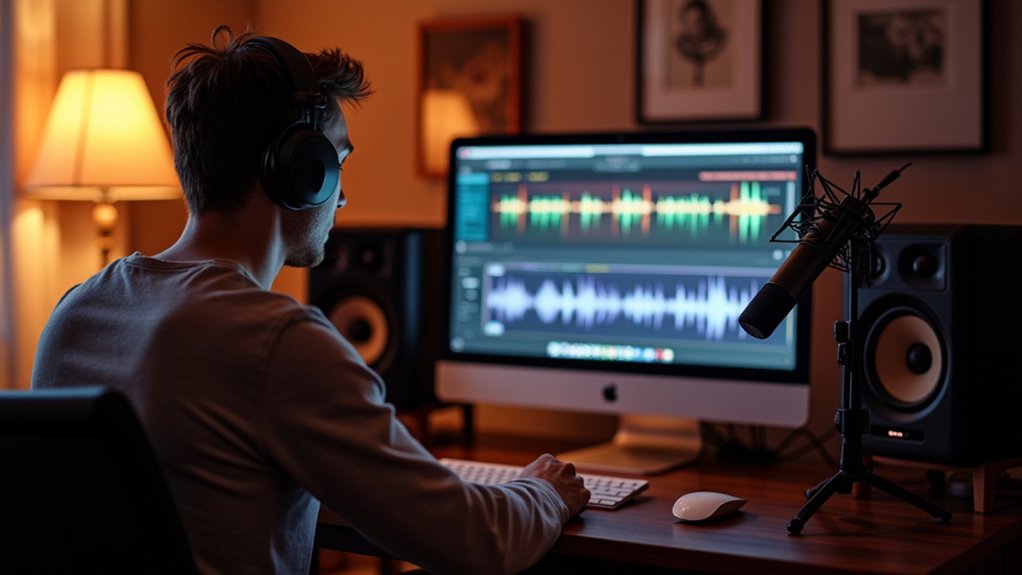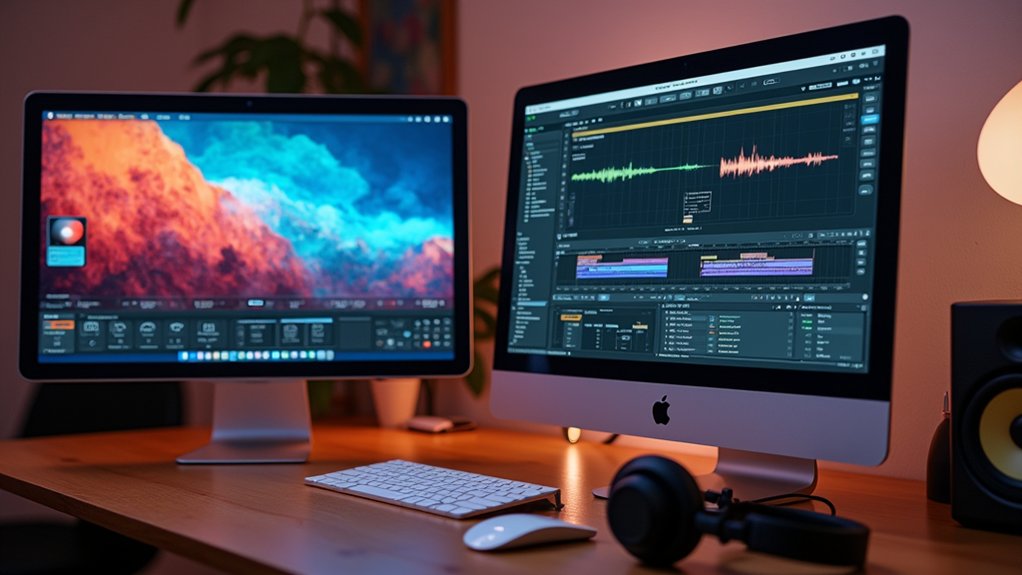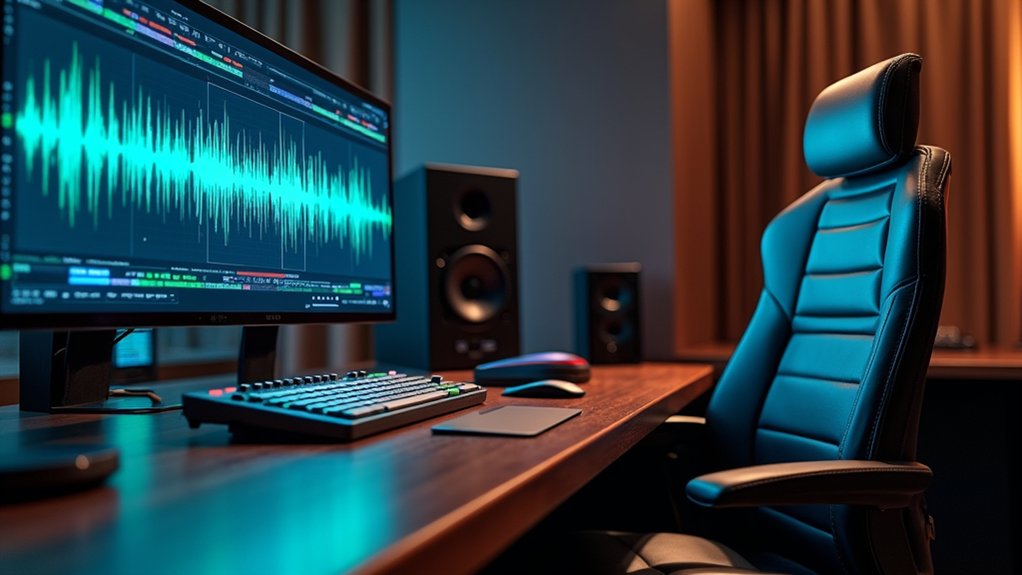Audacity is a free, open-source audio editor focused on basic recording, editing, and format conversion, offering essential tools ideal for podcasts and simple audio manipulation. In contrast, FL Studio is a feature-rich digital audio workstation (DAW) suited for intricate music production, extensive multi-track editing, real-time effects, and advanced VST integration. Audacity prioritizes accessibility and simplicity, while FL Studio serves creative professionals with robust production capabilities. Further distinctions reveal how each platform addresses user needs and technical functions.
Key Takeaways
- Audacity is a free, open-source audio editor ideal for basic recording and editing tasks.
- FL Studio is a full-featured DAW with advanced music production, multi-track editing, and real-time effects.
- Audacity’s simple interface and minimal tools suit beginners, while FL Studio’s complex layout caters to advanced users.
- FL Studio offers extensive VST/plugin support and integration, while Audacity’s plugin capabilities are limited and less streamlined.
- Audacity is best for podcasts and basic audio work; FL Studio excels at professional music creation and intricate audio production.
Pricing and Accessibility
While evaluating digital audio workstations, pricing and accessibility are fundamental factors influencing user choice.
Audacity distinguishes itself as an audio editing software that is entirely free, eliminating any financial barriers to entry and making it highly accessible for users seeking basic editing functions. This zero-cost model is ideal for users prioritizing budget and straightforward audio editing tasks.
In contrast, FL Studio adopts a tiered pricing approach, with editions ranging from $99 to $899, reflecting scalability based on music production requirements. FL Studio’s one-time purchase provides long-term access to advanced features and plugin suites, positioning it as an investment for serious producers.
Both Audacity and FL Studio support Windows and macOS, ensuring cross-platform accessibility and broadening their potential user base within the audio editing software market.
User Interface and Ease of Use
Beyond pricing and platform compatibility, the user interface and ease of use play a pivotal role in determining workflow efficiency within digital audio workstations.
Audacity features a user-friendly interface with minimal icons and clearly labeled options, promoting accessibility for beginners. Its design emphasizes straightforward navigation, and tooltips appear when users hover over icons, streamlining the learning curve.
In contrast, FL Studio presents a complex interface comprised of multiple windows and a dense array of features, which may initially overwhelm inexperienced users. While FL Studio’s customizable interface offers advanced users workflow optimization, its intricacy can deter those seeking immediate usability.
Audio Recording and Editing Tools
Although both Audacity and FL Studio enable users to record and edit audio across multiple tracks, their toolsets differ greatly in scope and depth.
Audacity, as free software, focuses on streamlined audio recording and editing audio capabilities, offering functions like noise reduction, pitch correction, and support for formats including WAV, MP3, FLAC, and OGG. Its interface is optimized for swift multi-track editing, making it suitable for basic sound design, podcasting, and casual use.
In contrast, FL Studio operates as a full-featured digital audio workstation tailored for advanced music production. It incorporates extensive multi-track editing, a broad suite of audio effects, and advanced processing tools. Additionally, Audacity users can implement compression settings effectively to enhance vocal presence and maintain professional output.
FL Studio’s robust environment supports professional workflows, enabling intricate sound design and thorough project management not possible in simpler editors.
Music Production and Creative Features
When comparing music production and creative features, Audacity is limited to fundamental audio editing capabilities such as trimming, noise reduction, and pitch adjustment.
FL Studio distinguishes itself with robust support for creative plugins, advanced automation, and real-time effect processing.
This contrast positions FL Studio as a thorough environment for intricate music creation, while Audacity remains focused on straightforward audio manipulation.
Audio Editing Capabilities
While both Audacity and FL Studio serve as digital audio workstations, their audio editing capabilities diverge considerably regarding depth and creative potential.
Audacity is tailored for straightforward audio editing, such as noise reduction, pitch correction, and applying fundamental effects, making it appropriate for podcasting and basic manipulation of audio files. Its multitrack editing is limited, restricting advanced music production and intricate arrangement work.
By contrast, FL Studio is engineered for professional music production, offering advanced pattern-based sequencing, robust mixing and mastering tools, and seamless plugin support. FL Studio’s architecture allows for precise, non-destructive editing and complex arrangements, accommodating a vast array of audio file formats at high quality.
- Audacity: basic audio editing, limited multitrack, simple effects
- FL Studio: advanced sequencing, professional mixing and mastering
- FL Studio: superior plugin support, high-quality audio files
Creative Plugin Options
Beyond core editing functions, the breadth and sophistication of creative plugin options set Audacity and FL Studio apart for music production tasks.
FL Studio, as a full digital audio workstation, features an expansive ecosystem of built-in samples, loops, and advanced effects, supporting an extensive library of VST plugins. This thorough integration streamlines sound design and enhances creative flexibility, allowing producers to experiment with diverse sonic textures. Its pattern-based workflow further facilitates dynamic arrangement and real-time effect preview.
In contrast, Audacity’s plugin options focus primarily on audio editing and essential effects, with less streamlined VST integration and limited sound design capabilities. While both platforms support real-time effect previews, FL Studio’s robust community support and dedicated music production tools surpass Audacity’s basic creative offerings for modern producers.
Plugin, VST, and Integration Support
When evaluating plugin compatibility and variety, both Audacity and FL Studio support downloadable plugins and VSTs. Yet, FL Studio presents a broader selection tailored to advanced music production.
Integration workflow differs greatly, as FL Studio enables immediate plugin utilization with streamlined processes. In contrast, Audacity often involves manual steps and less automation.
Community resources further enhance FL Studio’s accessibility, allowing users to efficiently locate and implement new tools.
Plugin Compatibility and Variety
Plugin compatibility and variety are critical factors in digital audio workstations, directly impacting workflow efficiency and creative potential.
FL Studio demonstrates superior plugin compatibility by supporting a broader range of VST options, which greatly enhances its suitability for advanced music production. Its streamlined process for integrating plugins allows users to expand audio editing capabilities with minimal friction.
In contrast, Audacity supports downloadable plugins and VSTs but requires additional steps for integration, which can hinder usability, especially for beginners. The strong community support surrounding FL Studio further facilitates the discovery and effective implementation of third-party plugins, optimizing the digital audio workstation experience.
- FL Studio offers extensive VST options for diverse audio editing and music production needs
- Audacity’s plugin integration is less streamlined, impacting workflow efficiency
- Community support in FL Studio accelerates plugin adoption and troubleshooting
Integration Workflow Differences
While both Audacity and FL Studio facilitate the use of external plugins and VSTs, their integration workflows differ considerably in terms of efficiency and capability.
Audacity permits basic integration of downloadable plugins and VSTs, but its workflow is less streamlined, offering only 14% integration support. This limited connectivity restricts advanced audio production processes and advanced routing scenarios.
In contrast, FL Studio is engineered for seamless plugin and VST integration, providing 57% integration support and an environment optimized for managing multiple effects and sound generators.
FL Studio also supports real-time preview and advanced routing, allowing users to construct intricate audio production chains.
Additionally, robust community support in FL Studio enhances plugin utilization, ensuring efficient troubleshooting and access to a broader range of integration resources.
User Community, Support, and Updates
Although both Audacity and FL Studio present steep learning curves, their robust user communities play a critical role in facilitating user onboarding and problem-solving.
Audacity’s open-source software model encourages community-driven support and collaborative feature development, with a thorough network of online tutorials, forums, and user-generated content compensating for the absence of direct customer service.
In contrast, FL Studio offers extensive support via its active user community, complemented by official documentation and a commitment to lifetime free updates, ensuring long-term feature growth and platform stability.
Both platforms benefit from frequent updates, though FL Studio’s update policy provides a unique advantage for invested users.
Key distinctions include:
- Open-source collaboration in Audacity’s user community
- Lifetime free updates as a feature in FL Studio
- Extensive tutorial and support resources for both software
Frequently Asked Questions
Is FL Studio Better Than Audacity?
Evaluating whether FL Studio is better than Audacity depends on FL Studio features like advanced plugin support, superior audio quality, and extensive workflow. Audacity limitations include restricted editing tools, basic user interface, and distinct pricing differences favoring Audacity’s free model.
Can Audacity Be Used as a DAW?
Audacity offers audio editing and basic track manipulation, but limited plugin support, minimal MIDI capabilities, and lacks live performance, advanced user interface, and collaboration features, restricting its effectiveness as a thorough DAW for complex music production workflows.
Is FL Studio the Best DAW for Beginners?
Evaluating FL Studio features, its user interface and pattern-based workflow efficiency facilitate music production for beginners, though audio editing depth and software comparisons suggest alternative DAWs may offer gentler learning curves. Beginner tips and community resources enhance usability.
Can You Make Professional Music With Audacity?
Professional music production in Audacity is limited by its basic audio editing capabilities, lack of advanced track layering, minimal plugin support, and simple user interface. Additionally, its sound quality processing and absence of collaboration tools restrict professional workflow efficiency.
Conclusion
In conclusion, Audacity provides a streamlined, open-source platform ideal for straightforward audio recording and waveform editing, with minimal investment and a user-friendly interface. In contrast, FL Studio offers a thorough digital audio workstation environment, supporting advanced MIDI sequencing, integrated synthesizers, robust mixing, and extensive VST compatibility. The decision between the two depends on production requirements; Audacity excels in basic editing, while FL Studio delivers a full-featured suite for professional music composition, arrangement, and sound design.




